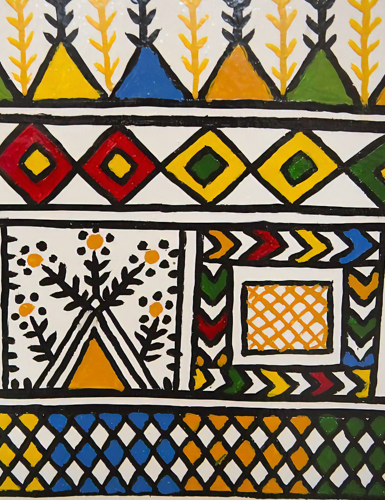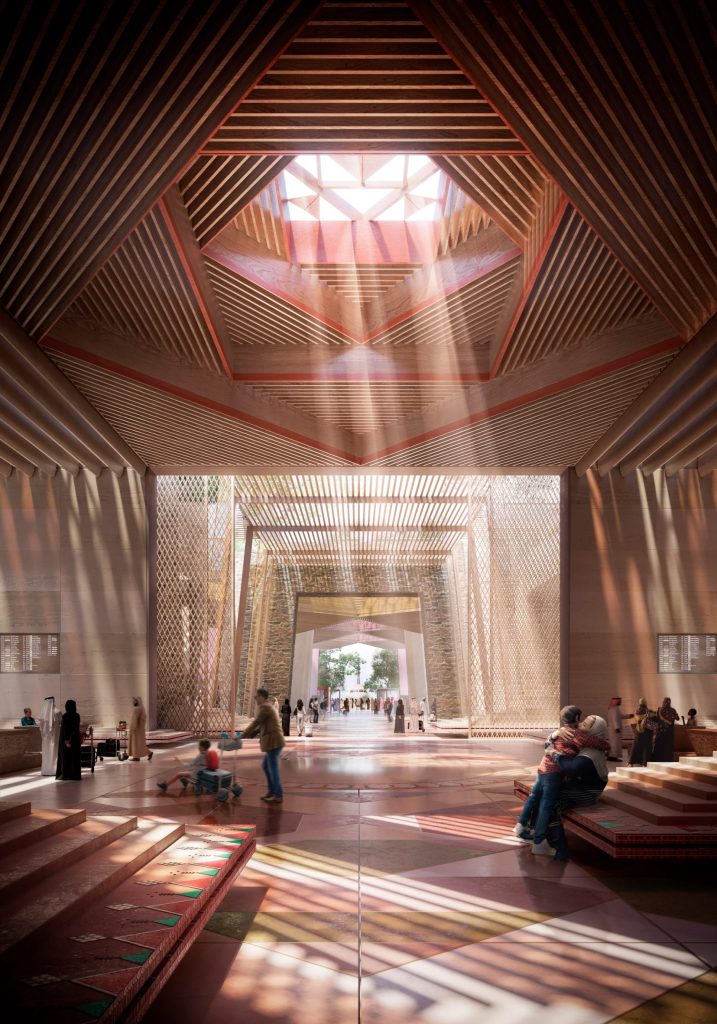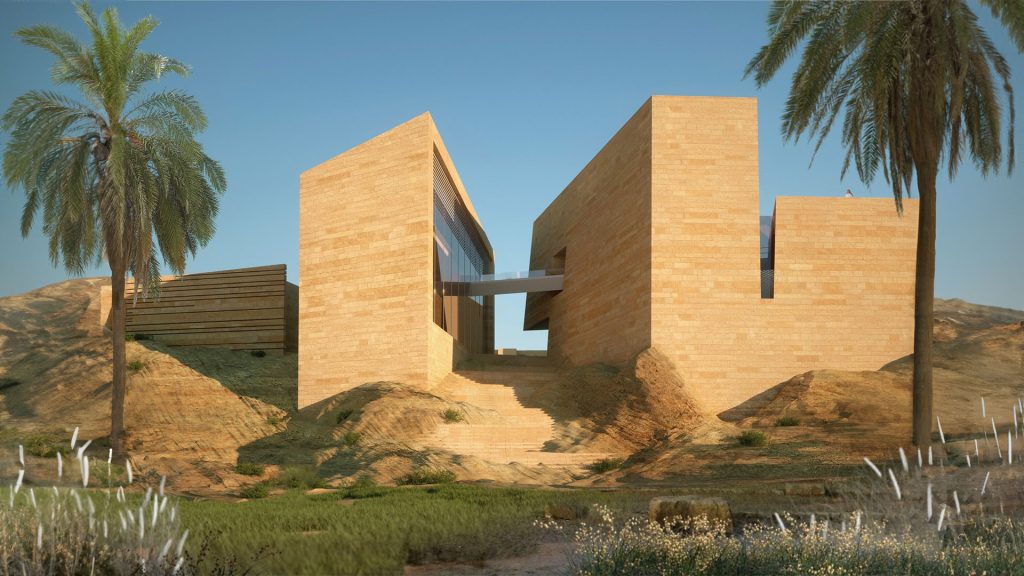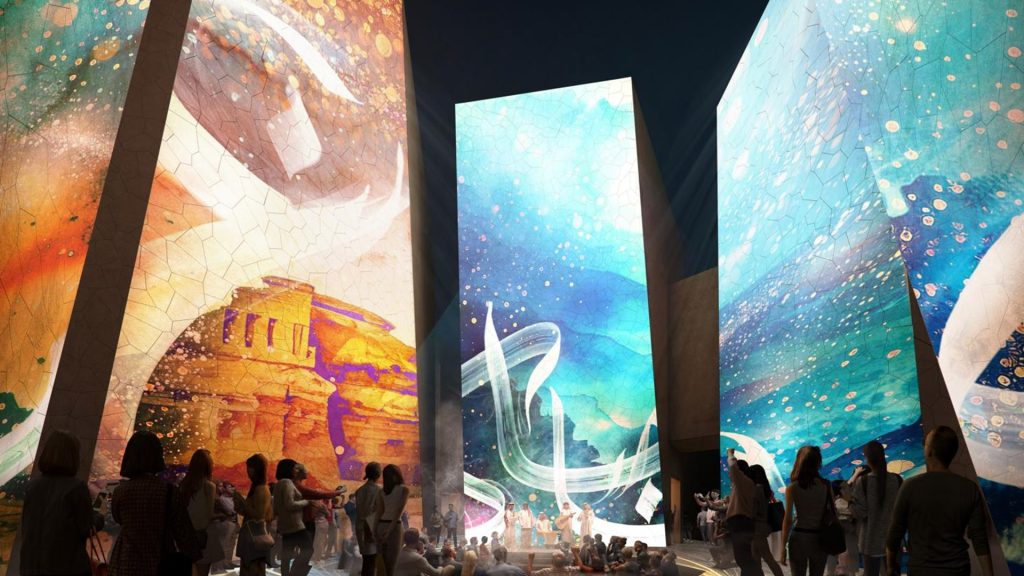Introduction
Embarking on a journey where tradition meets innovation, Foster + Partners unveils a groundbreaking design for Abha Airport in Saudi Arabia. In our exploration of ‘Aseeri Pathern Inspires Architecture Studio’s Tapered Stone Airport Design’, discover how the Aseeri heritage weaves seamlessly into the architectural tapestry, redefining the very essence of airport structures.
Table of Contents
Cultural Reverence: Aseeri Pattern Heritage Inspiring Airport Innovation
Foster + Partners’ design for Abha Airport serves as a poignant tribute to the cultural tapestry of the Aseer Region. The architects have meticulously incorporated traditional Aseeri pattern and design, intricately weaving elements inspired by local villages into the very fabric of the terminal. The result is a harmonious blend of architectural innovation and cultural heritage, where each stone and structure tell a story of the region’s rich history.
From the tapering stone buildings to the open-air courtyards, every facet of the design reflects a deep respect for Aseeri traditions, creating an airport that is not just a transit hub but a living testament to the enduring legacy of the local culture. Foster + Partners has masterfully transformed a functional space into a cultural landmark, inviting travelers to immerse themselves in the beauty and authenticity of the Aseer Region from the moment they step foot into Abha Airport.

Tapered Stone Elegance: Redefining Terminal Design

The architectural brilliance of the design of the airport lies in its unique elements that redefine the very essence of airport structures. The tapered stone buildings, varying in height, create a dynamic and visually striking skyline, departing from the conventional uniformity of traditional airports. Interconnected through open-air courtyards, these structures foster a sense of openness and connectivity, a departure from the enclosed nature of typical airport environments.
The deliberate choice of tapered stone not only adds an aesthetic appeal but also pays homage to local craftsmanship and materials. The play of varying heights and open-air spaces not only contributes to a visually stunning landscape but also enhances the functionality of the terminal.
This departure from the norm is not merely an aesthetic choice; it is a deliberate effort to redefine the passenger experience. The open-air courtyards provide spaces for relaxation and social interaction, breaking away from the traditional hustle and bustle of airport terminals. Travelers are offered a unique experience, where the architectural layout itself becomes a part of the journey.
Foster + Partners’ vision goes beyond mere functionality; it’s a statement about the potential of architectural innovation in transforming the very essence of travel spaces. The design of tapered stone buildings and interconnected open-air courtyards at Abha Airport challenges the conventional, inviting travelers into an environment that is not just a waypoint but a destination in itself. It’s a testament to how thoughtful architectural elements can redefine the expectations and experiences associated with airport structures, making Abha Airport a beacon of innovation in the realm of modern airport design.
Vibrant Interiors: A Fusion of Traditional and Modern Aesthetics
Foster + Partners’ design extends its innovation to the interior, where a careful and intentional blending of traditional and modern aesthetics unfolds. The juxtaposition of rough stone facades, inspired by nearby villages, against a more colorful and refined interior palette is a masterstroke that creates a distinctive and captivating atmosphere within the terminal.
The use of rough stone facades not only pays homage to the local vernacular but also establishes a visual connection with the surrounding villages, grounding the airport in its cultural context. This deliberate choice of materials echoes the authenticity of the Aseeri region, inviting travelers to embark on a sensory journey that starts even before takeoff.
In stark contrast, the interior palette takes a departure into a world of vibrant colors and refined textures. The infusion of modern elements, possibly inspired by the dynamic present and future of the region, creates a sense of progression and innovation. This duality – the rawness of tradition meeting the sophistication of modernity – defines the interior spaces of Abha Airport.
The seamless blending of these contrasting elements is a testament to Foster + Partners’ ability to weave narratives through architecture. Each step within the terminal becomes a transition between the rich history of the Aseeri region and its contemporary aspirations. The interior space becomes more than just a waiting area; it transforms into a symbolic gateway, reflecting the essence of the Aseer region – a harmonious fusion of tradition and progress.
Foster + Partners, through their adept use of interior design, has not only created a functional space but an immersive experience. Abha Airport stands as a living canvas where the past and present coalesce, offering travelers a glimpse into the rich heritage and promising future of the Aseer region from the moment they step inside.
Functional Sustainability: Natural Ventilation and Daylight Integration
Foster + Partners’ commitment to sustainability takes center stage in the design of Abha Airport, where innovative features are seamlessly integrated to harmonize with the region’s warm climate. The terminal’s layout is a thoughtful response to the environmental context, utilizing prevailing winds to provide natural ventilation across strategically placed courtyards.
In this arid climate, the open-air courtyards become more than aesthetic elements; they act as air channels, facilitating a constant flow of fresh air through the terminal. This not only enhances the overall comfort for passengers but significantly reduces the reliance on mechanical ventilation systems, marking a sustainable approach to energy use.
Moreover, the strategic use of stone walls serves a dual purpose. Beyond their aesthetic appeal, these walls act as thermal mass, absorbing heat during the day and releasing it at night, contributing to a more stable and comfortable indoor environment. The diffusion of daylight, facilitated by carefully positioned roof openings, further reduces the need for artificial lighting. This not only minimizes energy consumption but also creates a visually appealing play of light and shadow within the terminal spaces.
The integration of these sustainable features is a testament to Foster + Partners’ commitment to eco-friendly design. Abha Airport becomes a living example of how architecture can respond intelligently to its natural surroundings, minimizing environmental impact while enhancing the well-being of its occupants.
As the airport industry continues to evolve, projects like Abha Airport set a new standard for sustainability. Foster + Partners demonstrates that a focus on the environmental context, paired with strategic design choices, can result in not only aesthetically pleasing structures but also in spaces that tread lightly on the planet. The airport stands as a beacon of sustainable design, showcasing how thoughtful architecture can contribute to a more environmentally conscious and resilient future.
Community Connection: Landscaped Courtyards as Social Spaces in Saudi Airport
Foster + Partner’’ visionary design goes beyond conventional airport layouts by seamlessly integrating landscaped courtyards as communal focal points. These open spaces transcend their functional purpose, evolving into vibrant hubs that foster a profound sense of community and connection within the airport environment.
The decision to extend retail stores, restaurants, and cafes to the outdoors transforms these spaces into more than commercial entities – they become catalysts for social interaction. Travelers are invited to engage with each other and the environment, creating a shared experience that transcends the transient nature of air travel. The courtyards become meeting places, where people from diverse backgrounds converge, breaking down the barriers that often define airport spaces.
The significance of these open spaces lies in their ability to humanize the travel experience. Amidst the hustle of airport life, the landscaped courtyards offer a reprieve, a chance for individuals to connect with nature and each other. Whether enjoying a meal al fresco or simply taking a moment to appreciate the surroundings, these spaces contribute to a more relaxed and enjoyable journey.
Furthermore, the communal aspect extends to the cultural context of the Aseer Region. By emulating the layout of traditional villages where communal spaces are central, Foster + Partners pays homage to the local lifestyle. This intentional design choice not only respects the cultural heritage but also creates a distinctive sense of place within the airport.
In essence, the landscaped courtyards at Abha Airport become more than just aesthetically pleasing additions; they redefine the airport experience. They serve as platforms for cultural exchange, social interaction, and a shared appreciation for the environment. Foster + Partners, through their innovative approach, has transformed Abha Airport into a space that not only connects people with their destinations but also connects people with each other, turning a transient stop into a memorable part of the journey.
Conclusion
In the heart of Saudi Arabia’s Aseer Region, Foster + Partners has transformed airport architecture, uniting tradition and modernity. As we conclude our exploration, the tapered stone structures and vibrant interiors of Abha Airport stand as a testament to innovation, cultural reverence, and a harmonious fusion that welcomes travelers into a unique and unforgettable experience.



